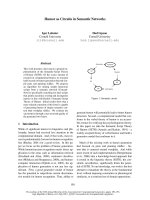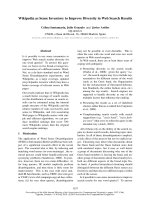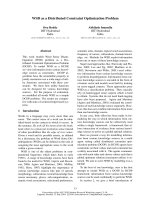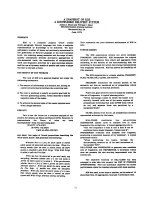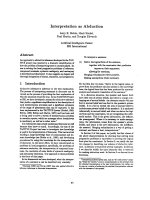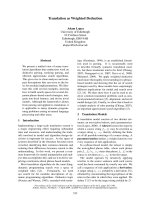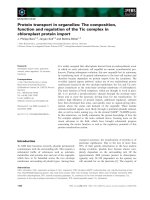Báo cáo khoa học: Peroxisomes as dynamic organelles: autophagic degradation pot
Bạn đang xem bản rút gọn của tài liệu. Xem và tải ngay bản đầy đủ của tài liệu tại đây (230.27 KB, 6 trang )
MINIREVIEW
Peroxisomes as dynamic organelles: autophagic
degradation
Masahide Oku
1
and Yasuyoshi Sakai
1,2
1 Division of Applied Life Sciences, Graduate School of Agriculture, Kyoto University, Japan
2 CREST, Japan Science and Technology Agency, Tokyo, Japan
Introduction
The dynamic nature of peroxisomes is supported by
various molecular mechanisms of organelle biogenesis
(augmentation) and degradation. In this review we
focus on the mechanism of autophagic degradation of
this organelle. Studies on another aspect of peroxisome
dynamics (i.e. peroxisome biogenesis) are elaborately
reviewed in the review by Wolf et al. in this miniseries
[1]. In addition, a comprehensive review on peroxisome
dynamics in yeast experimental systems can be found,
in this miniseries, in the review by Saraya et al. [2].
As with other organelles, such as mitochondria,
autophagy is considered to play a major role in the
degradation of peroxisomes, and there are reports of
lipooxygenase-mediated degradation of peroxisomes
[3]. The existence of pexophagy was recognized at a
very early stage of cell biology in a milestone report by
de Duve and Baudhuin, where ‘peroxisomes’ were
defined [4]. Therein the authors made a statement that
‘Like other cytoplasmic components, microbodies (des-
ignated as peroxisomes in this report) do occasionally
occur within autophagic vacuoles, in which case they
are presumably destroyed by the lysosomal enzymes,’
which clearly represents the autophagic degradation of
peroxisomes.
Biochemical and morphological studies of peroxi-
some degradation in several methylotrophic yeasts
(which are capable of growth on methanol as a sole
carbon source) identified the selective mode of auto-
phagic degradation of peroxisomes [5,6], giving birth
to the term ‘pexophagy’. And in the last decade, more
than 30 gene products necessary for pexophagy and ⁄ or
autophagy have been identified [7]. Among them, we
Keywords
autophagy; lysosome; organelle turnover;
peroxisomes; protein degradation; vacuole
Correspondence
Y. Sakai, Division of Applied Life Sciences,
Graduate School of Agriculture, Kyoto
University, Kitashirakawa-Oiwake, Sakyo,
Kyoto 606-8502, Japan
Fax: +81 75 753 6454
Tel: +81 75 753 6385
E-mail:
(Received 18 January 2010, revised 20 May
2010, accepted 2 June 2010)
doi:10.1111/j.1742-4658.2010.07741.x
Eukaryotic cells have to regulate peroxisomal metabolism to meet their
environmental or developmental requirements. Therefore, the control of
peroxisome number, which is mediated not only by proliferation but also
by degradation, is an important cellular event. Here we briefly review stud-
ies on the autophagic degradation of peroxisomes, a process now termed
pexophagy. Recent advances in molecular analyses of both nonselective
and selective autophagic pathways have revealed a category of autophagy-
related genes (ATG), many of which are shared in different pathways. In
this review we introduce the functions of the shared ATG products, along
with their interactions with peroxisomal factors. Physiological functions of
this process (especially cellular remodeling) in mammalian cells and in a
phytopathogenic fungus are also introduced.
Abbreviations
ATG, autophagy-related genes; LC3, microtubule-associated protein 1 light chain 3; MIPA, micropexophagic membrane apparatus;
PAS, phagophore assembly site; PAS, pre-autophagosomal structure; PE, phosphatidylethanolamine.
FEBS Journal 277 (2010) 3289–3294 ª 2010 The Authors Journal compilation ª 2010 FEBS 3289
herein focus on two groups of such molecular machin-
eries: the core factors for forming pexophagic mem-
brane structures; and interface molecules between
peroxisomes and autophagic membrane structures. In
the last part of this review, we introduce the physiolog-
ical roles of pexophagy in mammalian cells and in a
phytopathogen that were proposed in recent studies.
Core factors for membrane formation
in pexophagy
Ubiquitin-like conjugation system
Autophagy transports various intracellular components
from the cytosol to vacuoles – for example peroxi-
somes (pexophagy), mitochondria (mitophagy), ribo-
somes (ribophagy) and several vacuolar enzymes
including a precursor form of aminopeptidase I (Cvt
pathway) – in both a selective and nonselective man-
ner. All of these pathways employ common machinery
involving two ubiquitin-like conjugation systems for
de novo formation of the double-membrane structures
to enwrap and transport the targets. These systems
produce two covalent conjugates, Atg12–Atg5 and
Atg8–phosphatidylethanolamine (PE) [8,9]. The homo-
log protein of Atg8 in mammalian experimental sys-
tems is termed microtubule-associated protein 1 light
chain 3 (LC3), and the form conjugated to PE is desig-
nated LC3-II. As a portion of the Atg8–PE bond is
further cleaved by Atg4, Atg8 can undergo conjuga-
tion and deconjugation cycles. During pexophagy,
components of the two ubiquitin-like conjugation sys-
tems are required to form autophagic membrane struc-
tures enwrapping peroxisomes (pexophagosomes;
Fig. 1), and Atg8–PE is located on the pexophago-
somes [10–13].
These conjugation reactions are also involved in
‘micropexophagy’, where the vacuolar membrane
directly engulfs peroxisomes (Fig. 1). This mode of
pexophagy was first discovered in the methylotrophic
yeast Pichia pastoris, when the organism was cultured
in methanol to induce peroxisomes and subsequently
transferred to glucose medium where the peroxisomes
were no longer needed for methanol metabolism [14].
Under this culture condition, the PE-conjugated Atg8
marked a de novo-formed, cup-shaped membrane
structure on the peroxisome surface (Fig. 1) [15]. As
this peculiar structure was morphologically distinct
from pexophagosomes, it was named the micropexo-
phagic membrane apparatus (MIPA). A membrane-
fusion event between MIPA and the vacuolar mem-
brane was observed immediately before the completion
of peroxisome transport into the vacuole. Therefore,
MIPA was assumed to mediate the fusion between the
opposing tips of the invaginating vacuole to complete
sequestration from the cytosol.
Phagophore assembly site formation
Studies of yeast autophagy show that, for the conjuga-
tion processes and subsequent membrane formation to
occur, many Atg proteins form a complex at a specific
site termed the pre-autophagosomal structure or
phagophore assembly site (PAS) [16] [17]. Two Atg
proteins, Atg11 and Atg17, function as scaffold pro-
teins for PAS formation [18]. Both Atg11 and Atg17
interact with a pivotal kinase for autophagy, Atg1.
The scaffold proteins are required for the recruitment
of other Atg proteins to PAS. The recruited proteins
include components of the autophagy-specific phos-
phatidylinositol 3¢-kinase complex (Atg14, Vps15,
Vps30 ⁄ Atg6 and Vps34), a putative transmembrane
protein (Atg9) and factors involving the ubiquitin-like
conjugation system [18].
In Saccharomyces cerevisiae and P. pastoris, selective
transport of the aminopeptidase I precursor into the
Fig. 1. Two distinct modes of pexophagy:
macropexophagy and micropexophagy. In
macropexophagy, the peroxisomes are first
sequestered from the cytoplasm by an
isolation membrane, forming pexophago-
somes. In micropexophagy, MIPA, as well
as the vacuolar membrane, engulfs the
peroxisomes. The counterpart protein and
organelles in mammalian systems are
indicated in parentheses.
Autophagic degradation of peroxisomes M. Oku and Y. Sakai
3290 FEBS Journal 277 (2010) 3289–3294 ª 2010 The Authors Journal compilation ª 2010 FEBS
vacuole (Cvt pathway) is dependent on Atg11 [19,20].
Similarly to this Cvt pathway, the pexophagy process
in yeast systems requires Atg11 homolog proteins
[20,21], suggesting the existence of a common PAS-for-
mation machinery for selective autophagic pathways.
Furthermore, a recent study using P. pastoris demon-
strated that Atg17 was also involved in efficient degra-
dation of peroxisomes, presumably by recruiting the
peroxisome–autophagosome interface factor, Atg30
(described below), in combination with Atg11 [22].
In a mammalian system, a putative counterpart of
the scaffold protein, FIP200, was found to function in
starvation-induced bulk autophagy [23]. Thus, it is ques-
tioned whether FIP200 or other yet-unknown counter-
part proteins are involved in mammalian pexophagy.
Membrane traffic in P. pastoris pexophagy
Recent studies of P. pastoris pexophagy suggested the
existence of membrane flow from authentic organelles
to MIPA or pexophagosomes. One study indicated
that a Golgi-resident phosphatidylinositol 4-kinase,
Pik1, was necessary for the formation of MIPA, and
that MIPA was rich in the product of phosphatidylino-
sitol 4-kinase, (i.e. phosphatidylinositol 4-phosphate)
[24]. As Pik1 was not detected in MIPA during
micropexophagy, some transport machinery of phos-
phatidylinositol 4-phosphate was expected, but the
molecular details of this transport remain elusive.
Another study showed that a small GTPase, Sar1,
previously known to function in vesicle budding from
the endoplasmic reticulum, was involved in the pexo-
phagy process of P. pastoris [25]. Two mutant deriva-
tives of this protein were utilized in this study: a T34N
form that has high affinity for GDP and an H79G
form that is impaired in its GTPase activity. While
both T34N and H79G mutants inhibited MIPA forma-
tion, T34N hampered pexophagosome formation, and
H79G expression led to pexophagosomes that were
incapable of fusion with the vacuolar membrane. Inter-
estingly, the pexophagosomes formed during H79G
expression contained the endoplasmic reticulum mar-
ker DsRFP–HDEL, suggesting a traffic link between
the endoplasmic reticulum and pexophagosomes.
Interface molecules between
peroxisomes and autophagic
components
Peroxisomal components for pexophagy
The autophagic selectivity towards peroxisomes is
assumed to be defined at the interface of peroxisomal
and pexophagosomal membranes. The peroxisomal
factor responsible for pexophagy was first identified in
the study of the methylotrophic yeast Hansenula poly-
morpha [26]. This study identified Pex14, the gateway
membrane protein that imports peroxisomal matrix
proteins, as an essential factor for selective organelle
degradation, and demonstrated the functional role of
its N-terminal region.
Pex14 was also demonstrated to be involved in
mammalian autophagy of peroxisomes following nutri-
ent starvation and resupplementation; in this case,
Pex14 formed a complex with LC3–PE (LC3-II), which
was dependent on intact microtubules [27]. Interest-
ingly, the Pex14–LC3-II and Pex14–Pex5 interactions
seemed to be mutually exclusive, suggesting that the
competitive interactions act as a molecular switch that
induces peroxisome degradation (Fig. 2).
Pex3 is another peroxisomal membrane factor asso-
ciated with organelle degradation. In H. polymorpha,
this protein was rapidly degraded before organelle deg-
radation per se [28], and inhibiting Pex3 degradation
caused persistence of peroxisomes, even under pexo-
phagic conditions, suggesting that the degradation of
Pex3 was necessary for pexophagy in this organism
(Fig. 2).
Receptor proteins for pexophagy
In selective autophagy, receptor proteins are often uti-
lized to link the targets and the double-membrane for-
mation machinery. In the S. cerevisiae Cvt pathway,
the precursor form of aminopeptidase I (the cargo)
interacts with a receptor protein, termed Atg19, that
Fig. 2. Interactions between peroxisomal and autophagic factors.
The dashed lines indicate the interactions revealed by immunopre-
cipitation analysis, and the solid lines indicate those confirmed
by both immunoprecipitation and yeast two-hybrid analyses.
Hp, Hansenula polymorpha; P, phosphorylation; Pp, Pichia pastoris.
M. Oku and Y. Sakai Autophagic degradation of peroxisomes
FEBS Journal 277 (2010) 3289–3294 ª 2010 The Authors Journal compilation ª 2010 FEBS 3291
binds to both Atg11 and Atg8 [17]. In the mammalian
autophagic system for ubiquitinated protein aggre-
gates, the ubiquitin moiety is captured by p62 (seques-
tosome 1), which binds to LC3 [17].
The receptor protein for pexophagy was first identi-
fied in P. pastoris [29]. This protein, termed Atg30,
was phosphorylated depending on its interacting part-
ner, Pex3, which enabled it to form complex with
Atg11. This protein, which interacts with Atg17 and
also Pex14, functions as a pivotal factor between the
peroxisomal surface and the autophagic core compo-
nents (Fig. 2). However, counterpart proteins of Atg30
are not found in the genomes of higher eukaryotes, or
even in the genomes of other yeasts, including S. cere-
visiae; the type of molecule that functions in place of
Atg30 in other organisms remains unknown. Recently,
artificial tagging of peroxisomal membrane proteins
with ubiquitin was found to trigger p62-dependent
organelle degradation [30]. Thus, it is plausible to
assume that p62 acts as a receptor protein for pexo-
phagy by recognizing endogenously ubiquitinated per-
oxisomal proteins.
Physiological roles of pexophagy
Pexophagy for quantitative regulation of
peroxisomes
In mammalian cells, selective autophagy of peroxi-
somes was observed after organelle proliferation fol-
lowing stimulation with di-(2-ethylhexyl) phthalate and
subsequent chase culture (without the reagent) [10].
Electron microscopy of hepatocytes under this experi-
mental condition revealed selective surrounding of per-
oxisomes by pexophagosomes and demonstrated a role
for pexophagy in control of the organelle quantity in
response to the change in cellular metabolism.
Besides such inducible pexophagy responding to met-
abolic changes, constitutive autophagy of peroxisomes
was also observed in cultured mammalian cells [31].
The turnover rate of peroxisomes, which is sensitive to
3-methyladenine, a phosphatidylinositol 3-kinase inhib-
itor that impairs autophagy, was estimated to be 30%
of the total population per day in cells under normal
experimental conditions analyzed using the Halo-tag
technique, which labels a target protein with a fluores-
cent label at any given time-point by exogenous addi-
tion of a specific ligand. These data are significant in
that they show the rate of constitutive turnover of the
organelle, yet it has not been fully clarified whether
this turnover is the outcome of selective autophagy
towards peroxisomes, or of bulk autophagy that even-
tually transports the organelle into the lysosome.
Pexophagy for cellular remodeling during cell
differentiation
A recent study of the plant pathogenic fungus Colleto-
trichum orbiculare demonstrated a novel role of pexo-
phagy in the pathogenicity of this organism [32]. To
invade host plants, this fungus forms a specific infec-
tion structure termed an appressorium (Fig. 3). While
it is known that peroxisome biogenesis is necessary for
the formation of a functional appressorium that con-
tains melanin, a pigment essential for phytopathogenic-
ity (pexophagy) in the same structure was found to be
required for the subsequent invasion step.
Atg26, a sterol glucosyltransferase, was the key mol-
ecule of this pexophagy process. This molecule had
been identified as an essential factor for pexophagy in
Fig. 3. Cartoons showing cell differentiation
of Colletotrichum orbiculare for invasion into
host plants. First, the conidium (asexual
spore) germinates and develops the appres-
sorium whose melanization and functionality
depend on peroxisomal metabolic function.
In the next step the peroxisomes in the
appressorium are degraded by pexophagy,
which is necessary for the formation of
hypha to invade into the host plant.
Autophagic degradation of peroxisomes M. Oku and Y. Sakai
3292 FEBS Journal 277 (2010) 3289–3294 ª 2010 The Authors Journal compilation ª 2010 FEBS
methanol-induced P. pastoris [22,33]. The GRAM
domain (named after glucosyltransferase, Rab-like
GTPases, and myotubularins, which harbor this
domain) of Atg26 is conserved and involved in pexo-
phagy in both C. orbiculare and P. pastoris. As this
molecule is not required for starvation-induced bulk
autophagy [33], the physiological importance of
selective autophagy of peroxisomes (pexophagy) is
suggested.
The precise molecular mechanism of how pexophagy
in the C. orbiculare appressorium leads to invasion of
the host plant is currently unknown. Notably, the
atg26 mutant strain was able to invade heat-shocked
plants whose defense responses were impaired and who
were more resistant to high concentrations of glycerol,
which collapsed the wild-type strain [32]. Taken
together, it is suggested that the cell integrity of the
appressorium, including the control of turgor pressure,
is impaired without pexophagy, which decreases the
ability of the fungus to overcome the defense responses
of the host plant.
Conclusion and future perspectives
After identification of general ATG gene products
involved in both nonselective and selective autophagic
pathways, pexophagy has been considered to be a good
model system for selective autophagy to pursue how the
peroxisomes are specifically wrapped by the pexophagic
membrane structures. Recent studies revealed the inter-
action of general ATG gene products with some peroxi-
somal molecules at its membrane. In the upcoming
years, progress revealing the detailed mechanism of
selectivity acquisition and pexophagy regulation is
expected. It will be possible to elucidate the physiologi-
cal functions of pexophagy at the organism level based
on knowledge acquired at the molecular level.
Acknowledgements
This study was supported by Grants-in-Aid for Scien-
tific Research on Priority Areas 18076002, by Grants-
in-Aid for Scientific Research (B) 22380052, and by a
grant from JST, CREST.
References
1 Wolf J, Schliebs W & Erdmann R. Peroxisomes as
dynamic organelles: peroxisomal matrix protein import.
FEBS J 277, 3268–3278.
2 Saraya R, Veenhuis M & van der Klei IJ. Peroxisomes
as dynamic organelles: peroxisome abundance in yeast.
FEBS J 277, 3279–3288.
3 Yokota S & Dariush Fahimi H (2009) Degradation of
excess peroxisomes in mammalian liver cells by auto-
phagy and other mechanisms. Histochem Cell Biol 131,
455–458.
4 De Duve C & Baudhuin P (1966) Peroxisomes (micro-
bodies and related particles). Physiol Rev 46, 323–357.
5 Bormann C & Sahm H (1978) Degradation of micro-
bodies in relation to activities of alcohol oxidase and
catalase in Candida boidinii. Arch Microbiol 117,
67–72.
6 Veenhuis M, Douma A, Harder W & Osumi M
(1983) Degradation and turnover of peroxisomes in
the yeast Hansenula polymorpha induced by selective
inactivation of peroxisomal enzymes. Arch Microbiol
134, 193–203.
7 Sakai Y, Oku M, van der Klei IJ & Kiel JA (2006)
Pexophagy: autophagic degradation of peroxisomes.
Biochim Biophys Acta 1763, 1767–1775.
8 Ichimura Y, Kirisako T, Takao T, Satomi Y,
Shimonishi Y, Ishihara N, Mizushima N, Tanida I,
Kominami E, Ohsumi M et al. (2000) A ubiquitin-like
system mediates protein lipidation. Nature 408, 488–
492.
9 Mizushima N, Noda T, Yoshimori T, Tanaka Y, Ishii
T, George MD, Klionsky DJ, Ohsumi M & Ohsumi Y
(1998) A protein conjugation system essential for auto-
phagy. Nature 395, 395–398.
10 Iwata J, Ezaki J, Komatsu M, Yokota S, Ueno T,
Tanida I, Chiba T, Tanaka K & Kominami E (2006)
Excess peroxisomes are degraded by autophagic
machinery in mammals. J Biol Chem 281, 4035–4041.
11 Monastyrska I, van der Heide M, Krikken AM, Kiel
JA, van der Klei IJ & Veenhuis M (2005) Atg8 is essen-
tial for macropexophagy in Hansenula polymorpha.
Traffic 6, 66–74.
12 Mukaiyama H, Oku M, Baba M, Samizo T, Hammond
AT, Glick BS, Kato N & Sakai Y (2002) Paz2 and 13
other PAZ gene products regulate vacuolar engulfment
of peroxisomes during micropexophagy. Genes Cells 7,
75–90.
13 Yuan W, Stromhaug PE & Dunn WA Jr (1999)
Glucose-induced autophagy of peroxisomes in Pichia
pastoris requires a unique E1-like protein. Mol Biol Cell
10, 1353–1366.
14 Tuttle DL & Dunn WA Jr (1995) Divergent modes of
autophagy in the methylotrophic yeast Pichia pastoris.
J Cell Sci 108 (Pt 1), 25–35.
15 Mukaiyama H, Baba M, Osumi M, Aoyagi S, Kato N,
Ohsumi Y & Sakai Y (2004) Modification of a
ubiquitin-like protein Paz2 conducted micropexophagy
through formation of a novel membrane structure. Mol
Biol Cell 15, 58–70.
16 Noda T, Suzuki K & Ohsumi Y (2002) Yeast auto-
phagosomes: de novo formation of a membrane struc-
ture. Trends Cell Biol 12, 231–235.
M. Oku and Y. Sakai Autophagic degradation of peroxisomes
FEBS Journal 277 (2010) 3289–3294 ª 2010 The Authors Journal compilation ª 2010 FEBS 3293
17 Xie Z & Klionsky DJ (2007) Autophagosome forma-
tion: core machinery and adaptations. Nat Cell Biol 9,
1102–1109.
18 Suzuki K, Kubota Y, Sekito T & Ohsumi Y (2007)
Hierarchy of Atg proteins in pre-autophagosomal struc-
ture organization. Genes Cells 12, 209–218.
19 Farre JC, Vidal J & Subramani S (2007) A cytoplasm
to vacuole targeting pathway in P. pastoris. Autophagy
3, 230–234.
20 Kim J, Kamada Y, Stromhaug PE, Guan J, Hefner-
Gravink A, Baba M, Scott SV, Ohsumi Y, Dunn WA
Jr & Klionsky DJ (2001) Cvt9 ⁄ Gsa9 functions in
sequestering selective cytosolic cargo destined for the
vacuole. J Cell Biol 153, 381–396.
21 Hutchins MU, Veenhuis M & Klionsky DJ (1999)
Peroxisome degradation in Saccharomyces cerevisiae is
dependent on machinery of macroautophagy and the
Cvt pathway. J Cell Sci 112 (Pt 22), 4079–4087.
22 Nazarko TY, Farre JC & Subramani S (2009) Peroxi-
some size provides insights into the function of auto-
phagy-related proteins. Mol Biol Cell 20, 3828–3839.
23 Hara T, Takamura A, Kishi C, Iemura S, Natsume T,
Guan JL & Mizushima N (2008) FIP200, a ULK-inter-
acting protein, is required for autophagosome forma-
tion in mammalian cells. J Cell Biol 181, 497–510.
24 Yamashita S, Oku M, Wasada Y, Ano Y & Sakai Y
(2006) PI4P-signaling pathway for the synthesis of a
nascent membrane structure in selective autophagy.
J Cell Biol 173, 709–717.
25 Schroder LA, Ortiz MV & Dunn WA Jr (2008) The
membrane dynamics of pexophagy are influenced by
Sar1p in Pichia pastoris. Mol Biol Cell 19, 4888–4899.
26 Bellu AR, Komori M, van der Klei IJ, Kiel JA &
Veenhuis M (2001) Peroxisome biogenesis and selective
degradation converge at Pex14p. J Biol Chem 276,
44570–44574.
27 Hara-Kuge S & Fujiki Y (2008) The peroxin Pex14p is
involved in LC3-dependent degradation of mammalian
peroxisomes. Exp Cell Res 314, 3531–3541.
28 Bellu AR, Salomons FA, Kiel JA, Veenhuis M &
Van Der Klei IJ (2002) Removal of Pex3p is an
important initial stage in selective peroxisome degra-
dation in Hansenula polymorpha. J Biol Chem 277,
42875–42880.
29 Farre JC, Manjithaya R, Mathewson RD & Subramani
S (2008) PpAtg30 tags peroxisomes for turnover by
selective autophagy. Dev Cell 14, 365–376.
30 Kim PK, Hailey DW, Mullen RT & Lippincott-
Schwartz J (2008) Ubiquitin signals autophagic degra-
dation of cytosolic proteins and peroxisomes. Proc Natl
Acad Sci U S A 105, 20567–20574.
31 Huybrechts SJ, Van Veldhoven PP, Brees C, Mannaerts
GP, Los GV & Fransen M (2009) Peroxisome dynamics
in cultured mammalian cells. Traffic 10, 1722–1733.
32 Asakura M, Ninomiya S, Sugimoto M, Oku M,
Yamashita S, Okuno T, Sakai Y & Takano Y (2009)
Atg26-mediated pexophagy is required for host invasion
by the plant pathogenic fungus Colletotrichum orbicu-
lare. Plant Cell 21, 1291–1304.
33 Oku M, Warnecke D, Noda T, Muller F, Heinz E,
Mukaiyama H, Kato N & Sakai Y (2003) Peroxisome
degradation requires catalytically active sterol
glucosyltransferase with a GRAM domain. EMBO
J 22, 3231–3241.
Autophagic degradation of peroxisomes M. Oku and Y. Sakai
3294 FEBS Journal 277 (2010) 3289–3294 ª 2010 The Authors Journal compilation ª 2010 FEBS

